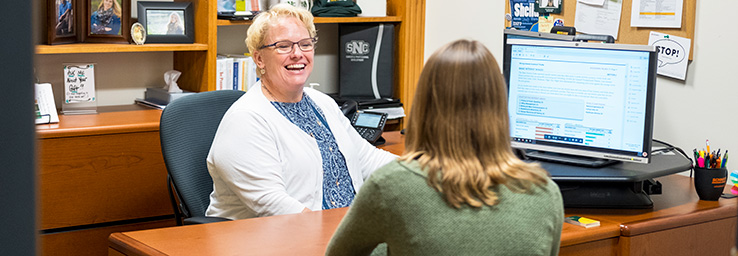
Résumé
One of the most important aspects of your job search is creating your résumé. On average, employers spend less than 30 seconds screening it, so it is essential for your résumé to project a clear and concise picture of your skills, experiences and achievements.
Résumé Guide (PDF)
Formatting Tips
- Length: One page résumés are recommended for current students and recent grads. However, education majors typically use a two-page résumé.
- Prioritize: Place your most important information toward the top of the résumé.
- Proofread: Check and recheck for spelling and grammatical errors. Have several individuals review your résumé and provide feedback.
- Format: Start with a blank Word document. Avoid using templates because they may not allow you to easily move information or change bullets, fonts or text sizes.
- Printing: Print your résumé on quality white or light-colored paper.
- Save: If emailing your résumé, use your name when saving the document. Be sure to save your résumé in multiple locations.
- Personal information: Do not include a photograph or other personal data information such as age, weight, height or marital status.
- Font: Use easy-to-read fonts (Ex: Times New Roman, Arial, Calibri, Cambria, etc.). Keep font sizes between 10 point and 12 point.
- Margins: Keep margin widths between .5” and 1”.
- Name: Make sure your name stands out by using a larger type size (16-22 points) and bolding it.
- Address and phone number: Include only one phone number and use a professional outgoing message on your phone. For example, “You have reached the voicemail of Julie Fox, I am sorry I missed your call. Please leave your name, number and brief message and I will return your call as soon as possible. Thanks!.” Include a campus address and a permanent address if you will be in different locations during your search.
- Email address: A combination of your first and last name keeps your email address professional
- Personal website/LinkedIn public profile: Include personal websites only if they are directly related to your objective and will enhance your candidacy.
An objective conveys key information about why you have applied to the employer. The objective can include the specific position you are seeking, skills you can apply on the job, organization type or field to which you are applying, or a combination of all of the above.
If you will be submitting a cover letter or application with your résumé, it is unlikely that you will need to include an objective statement on your résumé.
Education
Required content:
- St. Norbert College, De Pere, WI
- Degree name
- Graduation date (month and year)
- Major(s), minor(s) and concentration(s)
- Certification or licensure (if applicable)
- Cumulative GPA and/or major GPA, if greater than a 3.0 (Example: Major GPA: 3.7/4.0)
- Relevant coursework (include courses that directly relate to the career objective)
- Honors and awards (could be in its own section)
- Study-abroad experience (For examples, see the Marketing Your International Experience handout (PDF).
Experience
Experience can include paid or unpaid opportunities, part-time or full-time work, internships, volunteer work, significant leadership experience, class projects, etc. Being creative with your headings allows you to group experiences together based on similarities and is a stronger way to market your related experiences. Within each heading, your experiences should be listed in reverse chronological order.
Required content:
- Position title
- Organization name
- Location (city, state)
- Start date-end date (month and year–month and year)
Bullet point formatting:
- Bullet points describe your skills, experiences and accomplishments that relate to the objective of your résumé
- Bullets are quick points, not complete sentences
- A quality bullet point contains the following: action verb, duties, skills, and accomplishments
- When possible quantify (For example, Increased membership by 20%)
- Use present tense if the experience is current; past tense if the experience has been completed
- Use a variety of action verbs to start each bullet point
- Do not use personal pronouns
- Relevant experiences should have more bullets than non-relevant experiences
- Career-Related Experience
- Leadership
- Honors and Awards
- Community or Volunteer Service
- Presentations
- Additional Work Experience
- Publications
- Skills
- Major (e.g. Business, Art) Experience
- Related Projects
- Research Projects
- International Experience
- Language(s)
- Activities
- Computer Skills
- Professional Affiliations
Contact Us
Location
Todd Wehr Hall - 124
Hours of Operation
Monday-Friday
8 a.m.-4:30 p.m.
Phone: 920-403-3040
Email: careers@snc.edu
Connect With Us
![]() Like Career and Professional Development on Facebook.
Like Career and Professional Development on Facebook.![]() Connect With St. Norbert College Alumni and Friends on LinkedIn.
Connect With St. Norbert College Alumni and Friends on LinkedIn.![]() Follow our Backpack to Briefcase Board on Pinterest.
Follow our Backpack to Briefcase Board on Pinterest.













